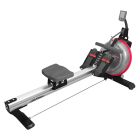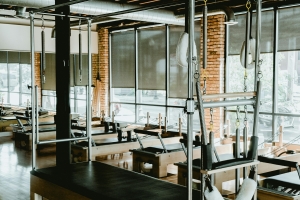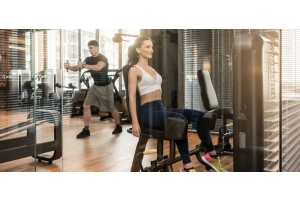Beginners Guide to Rowing
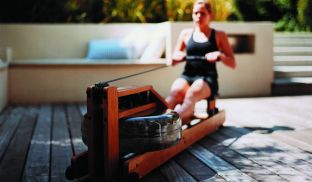
The benefits of indoor rowing are undisputed. No other gym equipment rivals the rowing machine when it comes to providing a calorie scorching, low impact, full body workout. When correctly executed, the rowing action uses every large muscle group in the body (roughly 85% of total muscle mass,) building lean muscle and kick starting the metabolic system from stroke one.
Beginners Guide to Indoor Rowing
The humble indoor rower also tops the list when it comes to training your cardiovascular system. Amongst athletes, elite rowers are renowned for having the biggest hearts and lungs going. British rower and Olympic Champion Pete Reed has the largest lung capacity ever recorded, a whopping 11.68 litres! To put that into perspective, Lance Armstrong’s lung capacity at his final Tour de France win was a mere 7 litres. However, you don’t have to be an elite athlete to workout on the rowing machine.
Once basic rowing technique is mastered (see below for advice,) the rowing machine is a piece of exercise equipment suitable for all ages and fitness levels. The beauty of indoor rowing is that it is a non-impact exercise that can be done at any effort level. Resistance is created by how hard you push or pull, so you have total control over the intensity of your own workout. Whether you are a hard-core crossfitter, or simply looking to do thirty minutes of moderately paced cardio work, indoor rowing is suitable for you.
Given the obvious fitness advantage of rowing it is surprising that until very recently, rowing machines were typically relegated to collecting dust in gym corners. It isn’t as if indoor rowing is a new concept - it is a little known fact that rowing machines sat pride of place on the gym floor of the Titanic! The good news is, for whatever reason, indoor rowing is currently undergoing a big renaissance in gyms, fitness studios, and homes up and down the country. We are in the midst of a rowing revolution. Don’t get left in the wake read on.
How to Row
Before embarking on a workout with the rower it is important to learn basic rowing form. Improper technique can negate many of indoor rowing’s physiological benefits, and on the rare occasion leads to injury. Fortunately, under the right instruction the basics of indoor rowing can be mastered in less than 10 minutes.
Although rowing should be a continuous motion, for ease of instruction the stroke can be broken down into distinct segments.
The Release
The release (also known as the finish,) is the first position to get into when starting the rowing stoke. Sit with flat legs, good posture, and leaning back just past vertical. Draw the handle into the bottom of your rib cage, elbows tucked behind the body.
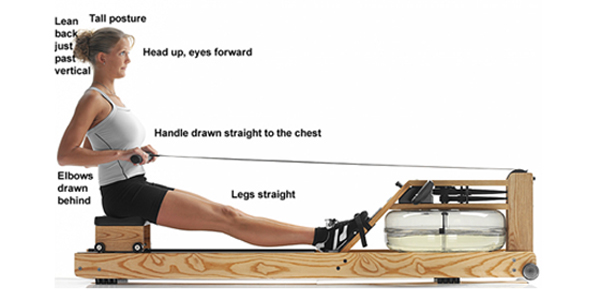
The Rock-Over
From the finish position, first push arms out. As the arms are almost straight, pivot from the hips maintaining good posture – a slight stretch should be felt in the hamstring. Be sure that the handle is clear of the knees.

The Recovery
From the rock over, whilst maintaining body position, release the knees and allow the seat to roll forward.
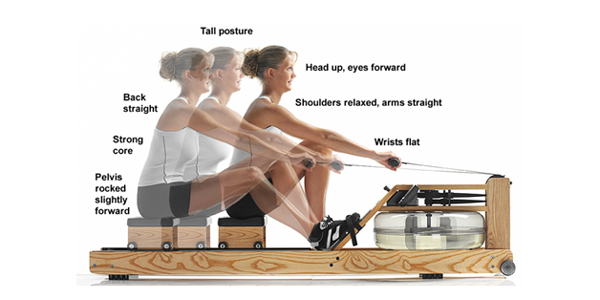
The Catch
The recovery ends at the catch when shins reach vertical, and the seat is close to the heels.

The Drive
This is the hard part of the stroke! The drive is where pressure is applied and dictates how fast you are going. In essence this is all the previous steps in reverse. The legs work first, followed by the trunk, and then finally the arms draw the handle back to the finish position.

…and repeat!
Rowing the Right Way
The temptation when you first get on a rowing machine is to take as many strokes as possible, as quickly as possible. The number of strokes taken each minute is known as SPM (strokes per minute) or Rate and is displayed on the performance monitor of all good rowing machines.
Commonly, rate is mistaken as an indication of how fast you are rowing. In fact, rowing machines measure intensity in a number of different units including watts, calories, and average 500m time. An effective stroke is long and powerful, not short and quick.
As a guide, for longer workouts (20+ minutes), sit at a lower rate, between 18 – 26 spm. For shorter more intense workouts take the rate higher, but be careful to maintain technique, keeping the strokes long and powerful.
Extra Hints
- It can often be helpful to row the stroke in smaller segments in order to get each position spot on. Try rowing with only the arms, only the trunk, and finally only the legs. Once you are happy with each movement, blend them together into a full rowing stoke
- Row next to a mirror - gives instant feedback on how your form is looking
- Throughout the rowing stroke feet should be in contact with the foot board. This gives a stable platform to leaver off
- Relax! A well-executed rowing stoke is loose and fluid, free from tension – think Usian Bolt rather than Dwain Chambers




